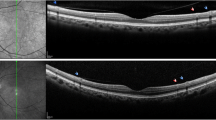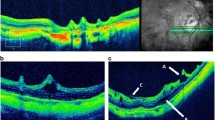Abstract
Purpose
We describe a case of high myopia who developed paravascular retinal rarefaction generated by vitreoretinal adhesion on retinal vessels detected using optical coherence tomography (OCT).
Methods
A 31-year-old man received a regular ophthalmologic examination for high myopia including detailed fundus examination and OCT.
Results
Detailed fundus examination revealed retinal rarefaction and fissure-like findings alongside the superior temporal retinal artery and vein in the right eye. OCT images revealed vitreoretinal adhesions on the retinal artery and a paravascular cystoid space in the inner retina. There was no retinal detachment. The axial length had increased by 1.50 mm over 15 years.
Conclusion
Paravascular retinal rarefaction as well as pseudohole formation caused by vitreoretinal adhesion on retinal vessels was detected in this patient using OCT. OCT might be useful to detect early-stage retinal pathologies caused by paravascular vitreoretinal traction in highly myopic patients.


Similar content being viewed by others
References
Coppe AM, Ripandelli G (2003) Optical coherence tomography in the evaluation of vitreoretinal disorders of the macula in highly myopic eyes. Semin Ophthalmol 18:85–88
Ikuno Y, Gomi F, Tano Y (2005) Potent retinal arteriolar traction as a possible cause of myopic foveoschisis. Am J Ophthalmol 139:462–467
Panozzo G, Mercanti A (2004) Optical coherence tomography findings in myopic traction maculopathy. Arch Ophthalmol 122:1455–1460
Phillips CI, Dobbie JG (1963) Posterior staphyloma and retinal detachment. Am J Ophthalmol 55:332–335
Regenbogen L, Stein R (1968) Retinal detachments due to juxtapapillary microholes. Arch Ophthalmol 80:155–160
Sayanagi K, Ikuno Y, Gomi F, Tano Y (2005) Retinal vascular microfolds in highly myopic eyes. Am J Ophthalmol 139:658–663
Spencer LM, Foos RY (1970) Paravascular vitreoretinal attachments. Arch Ophthalmol 84:557–564
Stirpe M, Heimann K (1996) Vitreous changes and retinal detachment in highly myopic eyes. Eur J Ophthalmol 6:50–58
Author information
Authors and Affiliations
Corresponding author
Rights and permissions
About this article
Cite this article
Ohno-Matsui, K., Hayashi, K., Tokoro, T. et al. Detection of paravascular retinal cysts before using OCT in a highly myopic patient. Graefe's Arch Clin Exp Ophthalmo 244, 642–644 (2006). https://doi.org/10.1007/s00417-005-0112-6
Received:
Revised:
Accepted:
Published:
Issue Date:
DOI: https://doi.org/10.1007/s00417-005-0112-6




